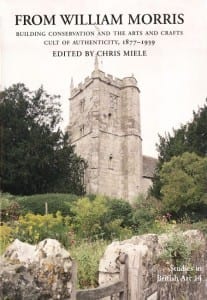From William Morris: Building conservation and the Arts and Crafts cult of authenticity 1877-1939 (2005)
From William Morris (2005), which addresses the history of heritage preservation in the United Kingdom – and elsewhere as in New England and Cyprus – is fourteenth in a series of occasional volumes dedicated to studies in British art. This study is of interest in the context of the history of British imperialism and world military history.
Edited by Chris Miele, From William Morris (2005) is published for the Paul Mellon Centre for Studies in British Art and the Yale Center for British Art. Paul Mellon was an art collector and philanthropist. His memoir is entitled Reflections in a silver spoon (1992).
Authenticity
The reference to a cult of authenticity brings to mind Charles Taylor’s overview of authenticity in the context of modernity. Another writer who comes to mind is Erving Goffman who explored authenticity in the context of impression management.
In Goffman’s formulation, in a given encounter or social interaction, an ongoing consensus regarding the authenticity or viability of an agreed-upon definition of a situation has to be maintained. Otherwise, the interaction falls apart and cannot be sustained.
With regard to the cult of authenticity, this January 2013 New Yorker article about the South and American authenticity also comes to mind.
Philip Webb effectively retired from architectural practice in 1900
A blurb on the inside cover of From William Morris (2005) notes:
“This book takes a fresh and wide-ranging look at the origins of the architectural conservation movement in the United Kingdom. Distinguished contributors consider how the modern concept of heritage emerged in the nineteenth century, how politics as well as art and design played a role in the creation of a historic buildings culture, and how the writings and activities of designer William Morris and architect Philip Webb shaped thinking about conservation.
“Chapters of the book address such diverse topics as the place of historic buildings in Morris’s thinking, the relation of the Arts and Crafts Movement to Victorian ideas of heritage, the distortion of Morrisian ideals in early twentieth-century New England, and the emergence of an urban vs. rural conservation culture. Drawing on extensive historical research, the book casts new light not only on the history of the Conservation Movement but also on its role today.”
What’s described as distortion of Morrisian ideals can as easily be framed, I would suggest, as an adaptation or appropriation of concepts proposed by William Morris.
The book discusses Philip Webb’s role in the Conservation Movement. Webb was particularly influential with regard to repair techniques. This key figure in the Morrisian movement effectively retired from architectural practice in 1900, as noted in a link in a previous paragraph:
“For the last fifteen years of his life Webb lived penuriously but contentedly in the country, having abandoned architecture at the onset of the ‘concrete’ age, with which he could feel no sympathy.”
Society for the Protection of Ancient Buildings
This impressive hardcover text – exquisitely laid out and illustrated but lacking an index – highlights the legacy of the Society for the Protection of Ancient Buildings, or SPAB, founded in 1877.
Paul Revere’s house
Among the topics that caught my interest is a discussion of the steps whereby Paul Revere’s house in Boston came to be preserved. Originally slated for demolition, the house was saved and has served as a source of patriotic edification for generations of American tourists.Regarding this topic, James M. Lindgren remarks (p. 231):
“So, what significance did historic preservation actually have in early twentieth-century New England? Quite simply, it had as much to do with ideology as the protection of old-time buildings. Reading colonial buildings as symbols of native character and testaments of Anglo-Saxon primacy, preservation mediated architecture, history, and cultural politics. Its development during the medieval and colonial revivals and the progressive movement made it primarily a means to accommodate the old and the new.
“Enamoured of New England’s rural past but reliant on its industrial future, preservationists fostered myths about the glories of the preindustrial community and countryside. Central to that mythology, and symbolised by the region’s oldest buildings, were the medieval origins of their Anglo-Saxon, Protestant culture. Believing that those structures should have a lasting impress, preservationists reinvented them by selectively restoring their imagined features, by removing them safely to folk parks and museums, and by highlighting their assumed history and importance.”
The book speaks as well of efforts in Great Britain to preserve historical buildings in the course of rebuilding after the Second World War. SPAB’s preservation efforts made a big difference in those years. Also of interest is a detailed overview of the history of SPAB’s involvement with the occasionally complicated preservation issues related to historic ecclesiastical buildings.
Climate change and heritage preservation
Heritage preservation has its won history which is related to other histories including cultural, social, military, and economic history.
As well, heritage preservation is not concerned solely with preservation of historically significant buildings. It’s also concerned with preservation of cultural landscapes.
As I was reading this book, it occurred to me that dealing with climate change involves addressing the integrity of a wide range of cultural landscapes. By way of example, Kerry Emmanuel, in What we know about climate change (2007, p. 50), notes that:
“Were the entire Greenland ice cap to melt, sea level would increase by around 22 feet – flooding many coastal regions including much of southern Florida and lower Manhattan.”
A more recent (2012) edition of the book is also available at the Toronto Public Library.
We speak of a desire to save historic buildings; we can similarly speak of a desire to save lower Manhattan and preserve it for the enjoyment of future generations.
Addendum
Here is a more recent article regarding the anticipated flooding of coastal regions as a consequence of climate change.


![PaulRevere(200)[1]_tcm3-2683](http://preservedstories.com/wp-content/uploads/2013/01/PaulRevere2001_tcm3-2683.jpg)
Leave a Reply
Want to join the discussion?Feel free to contribute!